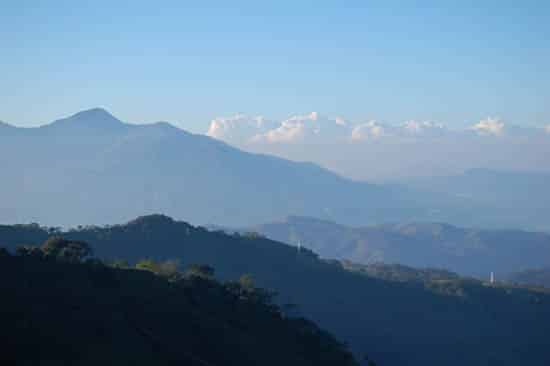Photo Showing Distance in Art Photo Showing Distance in Art Funny
Leonardo da Vinci – The Virgin of the Rocks (detail), 1491-1508
Why do mountains await blue in the altitude?
Have yous ever wondered why a hill, that you know is covered in green trees, looks purple or blue when viewed from a long distance abroad?
Trying to create a sense of depth and distance in your landscape painting is key for creating realism in your paintings.
The simplest way to do this is with Aerial perspective…

What is aerial perspective?
Aerial perspective is the optical effect that the atmosphere has on objects viewed at a long altitude.
For example, in the daytime, a mount range will ordinarily appear bluer and lighter equally it gets further and further away from us.
The air in the atmosphere contains various impurities and these human action as a filter stopping certain wavelengths of light reaching our eyes.
This gives the illusion of a change of color and value.
Absurd colours like dejection and greens get through the 'filter' of air more easily than the warm colours and so mountains ordinarily appear bluer.
Leonardo da Vinci noticed and studied that equally a landscape recedes from the viewer its colours and tones alter due to the nature of the temper.
Yous can encounter this in his painting above where he has cool blue muted mountains in the background, and warm browns in the foreground.
It is sometimes referred to as atmospheric perspective.
What consequence does aerial perspective take on mural painting?
Alter in colour – A green tree will quickly appear imperial, and then blue as it receded into the distance.
Change in tone – Everything gets paler, the atmosphere not merely affects the perceived colour in front of us merely the tones, how low-cal or how dark, each area of the landscape is. The changes are most noticeable in the dark tones, (just like the dark colour tones)

You can see in this photograph how obvious, now information technology's in blackness and white, the tonal value changes are.
It is as well useful to note how the crispness of line also alters, making the very back mount quite blurry.
Pro tip: It is often a good tip when painting to blur the furthest mountain into the heaven, You can mistiness it more than yous would initially think and the viewer will 'create' the mountain in their mind.
5 points to call up
- Every bit the altitude between y'all and the mountain increases, the contrast between the mount and its background (usually sky) decreases.
- The farther away a mount is the less detailed it becomes.
- The color becomes less and less saturated (intense) as it disappears into the altitude and becomes closer to the background colour. Every bit objects are viewed at increasing distances the colour change event is more pronounced, and (if viewed in the day) progressively from purple to blue. This will requite the illusion of depth.
- The elements most altered by aerial perspective are the nighttime tones, e.g: a night dark-green will modify more than dramatically than a light green.
- warm and cool – Use the power of warm and colours to add even more depth. Add a red highlight in the foreground to bring your viewers gaze forward and to enhance the effect. Warm in the foreground cools in the groundwork
Aerial perspective example:
Dark Dark-green forest scene on a clear, sunny twenty-four hours
Foreground: light green highlights – night greenish shadows
Middle ground: cooler green (towards blue)- green/purple hue to the shadows
(the lighter areas will also change but but a little libation green, rather than a consummate alter in hue)
Far Distant: light purple/blue highlights – bluish shadows with a purple/violet shade
Very far distance (50 miles) near white highlight – pale blue shadows
Everything gets lighter in value as the distance from the viewer increases, as the landscape hits the horizon line it is ofttimes very like in value to the sky.

Will Kemp, Scottish landscape, 2011
The areas that are lighter in value near the front of the scene volition hold onto their value for longer, the darks will turn to midtone quickly. Pure whites agree on to their value for a long distance then you can still apply titanium white to indicate houses in the far altitude as in the painting above.
A note on clouds


John Constable, Harwich Lighthouse, 1820
Pro tip: Clouds grow darker as they recede, instead of lighter, and they abound warmer instead of cooler. So on a articulate twenty-four hour period with clouds in the sky, the clouds go yellowish every bit they recede, and those way off in the distance will be pinkish.
You might likewise similar:
1. How to describe perspective for beginners
2. The secret of practiced limerick
Source: https://willkempartschool.com/how-to-instantly-add-depth-to-your-mountains-in-acrylic-landscape-painting/
0 Response to "Photo Showing Distance in Art Photo Showing Distance in Art Funny"
Post a Comment